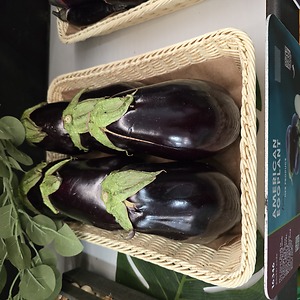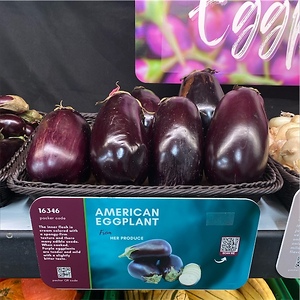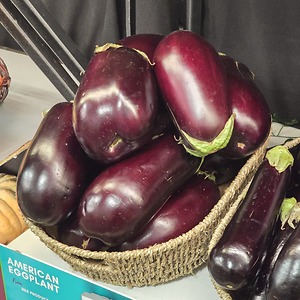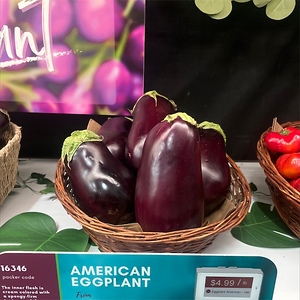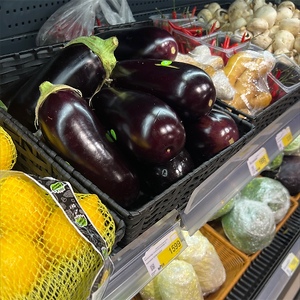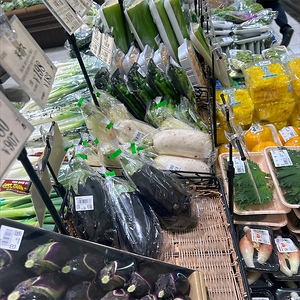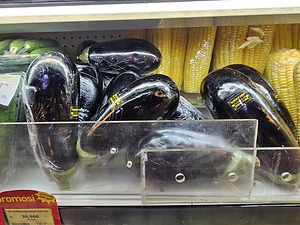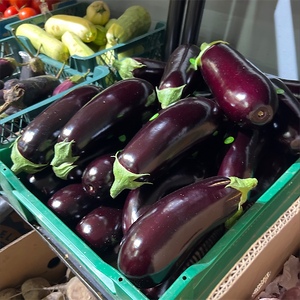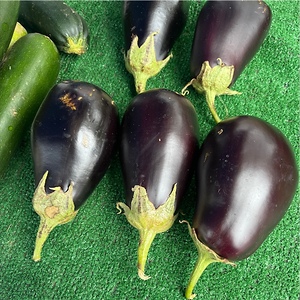

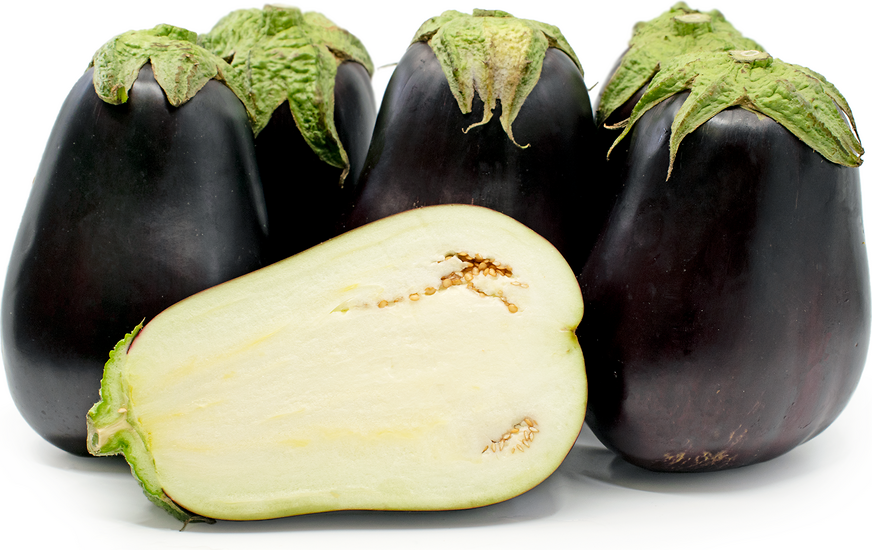
Purple Eggplant
Estimated Inventory, 18 ct : 22.26
This item was last sold on : 06/29/25
Description/Taste
Purple eggplants are large, oval-shaped vegetables with a bulbous bottom that slightly narrows towards their green-stemmed top. They measure about 18 to 25 centimeters long and 5 to 12 centimeters wide and have a dark purple-black hue with occasional faint patches of lighter purple. Their thin skin is smooth and shiny, requiring peeling in order to remove. Purple eggplants’ cream-colored flesh has a firm, spongy texture that becomes meltingly tender as it cooks and contains many small edible seeds. Purple eggplants have a mild and sweet flavor with a slight vegetal bitterness.
Seasons/Availability
Purple eggplants are available year-round with a peak season in summer.
Current Facts
Purple eggplants are botanically classified as Solanum melongena and belong to the Solanaceae, or nightshade, family along with potatoes, bell peppers, chilis, and tomatoes. They are technically fruits because they have seeds but are often labeled as vegetables because of how they are used in culinary applications. Purple eggplants are the most common cultivar in the Western world, with many varieties such as Chinese, Fairytale, Sicilian, Indian, Italian, Japanese, and Rosa Bianca eggplants. While most of these varieties are solid purple, others may be covered with varying degrees of white stripes. Although purple is the more common color, eggplants got their name because white varieties resemble eggs. This vegetable is referred to as Terung in Indonesia, Brinjal in Malaysia, Aubergine in France, and Alberengena in Spain. While Purple eggplants are primarily valued for their culinary uses, varieties like Solanum aethiopicum, also known as African eggplants or Pumpkin on a Stick, are grown mainly for their ornamental appeal.
Nutritional Value
The fiber in Purple eggplants supports digestion, helps regulate blood sugar levels, and promotes heart health by lowering cholesterol. The potassium in these vegetables is essential for maintaining healthy blood pressure, supporting muscle function, and reducing risk of stroke. Their vitamin C content acts as a powerful antioxidant, boosting the immune system and aiding in the repair and growth of tissues. Vitamin B-6 in eggplants plays a crucial role in brain development and function, as well as in the production of serotonin and norepinephrine, which regulates mood. Purple eggplants contain nasunin, an anthocyanin found in the skin that has potent antioxidant properties, protecting brain cells from oxidative stress and potentially slowing cognitive decline.
Applications
Purple eggplants are best suited for cooked applications such as grilling, pan frying, baking, sauteéing, and roasting. They are popularly breaded and fried into eggplant parmesan or used in pasta, stir-fries, pizzas, calzones, sandwiches, and casseroles. These vegetables are incorporated into foods across the world like ratatouille in France, moussaka in Greece, and baba ganoush in the Middle East. Purple eggplants can also be slow cooked in stews with rice, meats, vegetables, lentils, and noodles. They pair well with tomatoes, squashes, peppers, stewed meats, grilled and baked fish, chicken, chickpeas, lentils, basil, mint, cilantro, parsley, and mozzarella cheese. Purple eggplants will keep for up to three days when stored in a cool and dry place.
Ethnic/Cultural Info
In Northern Europe, eggplants were once called mad apples because they were thought to turn people insane. This was partially because their color caused them to be associated with a toxic dark purple berry plant called the Deadly Nightshade. Eggplants also had a reputation for giving people bad breath. It took centuries for people to accept eggplants as an edible and beneficial culinary ingredient, particularly in the United States. It wasn’t until Thomas Jefferson introduced them as an easily sown and cultivated vegetable that Americans started accepting eggplants into their diets.
Geography/History
Purple eggplants likely originated in China and India, where they have been cultivated for centuries. They flourish in warm climates with rich, sandy soils and full sun exposure. They can be found in the wild and in naturalized settings on commercial farms and home gardens. Purple eggplants were introduced into Southern and Eastern Europe by the Spanish Moors. They were brought to America in the 1500s but didn’t catch on until centuries later. Common Purple eggplant varieties with a large, oblong shape can be found at most supermarkets in the United States, Europe, Asia, and South America. Thinner, elongated eggplant varieties may be sourced from Asian and international specialty stores or farmers' markets.
Featured Restaurants
Restaurants currently purchasing this product as an ingredient for their menu.
| Burgo Direct | Chula Vista CA | 619-793-2325 |
| Merenda | Oceanside CA | 703-459-4145 |
| Inn at Rancho Santa Fe (Banquet) | Rancho Santa Fe CA | 858-381-8289 |
| Kensington Cafe | San Diego CA | 619-684-0044 Fausto |
| Tavola Nostra Pizzeria E Cucina | San Diego CA | 619-921-4206 |
| Glenbrook Health Center | Carlsbad CA | 760-704-1000 |
| Deeply Nourished | La Jolla CA | 808-489-7366 |
| Inn at Rancho Santa Fe | Rancho Santa Fe CA | 858-381-8289 |
| Urban Kitchen Catering | San Diego CA | 619-276-8803 |
| Villa Capri Poway | Poway CA | 858-391-9400 |
| Finca North Park | San Diego CA | 619-581-3003 |
| Viejas Casino Banquets | Alpine Ca | 619-295-3172 |
| Candor | La Jolla CA | 858-581-2205 |
| Pacific Yacht Agents | Los Angeles CA | 808-214-0970 |
| Pacific Regent La Jolla | San Diego CA | 858-597-8008 |
| Del Mar Country Club | Rancho Santa Fe CA | 858-759-5995 |
| Kona Kai Resort and Marina | San Diego CA | 619-221-8000 |
| Kitchens for Good (SD) | San Diego CA | 619-450-4040 |
| JRDN Restaurant | San Diego CA | 858-270-5736 |
| Tahona (Kitchen) | San Diego CA | 619-573-0289 |
| Coast Catering | Escondido CA | 619-295-3173 |
| Ketch Grill and Taps | San Diego CA | 858-268-1030 |
| Siamo Napoli | San Diego CA | 619-300-4810 |
| UCSD Food & Nutrition Department La Jolla | San Diego CA | 858-761-1269 |
| Trattoria I Trulli | Encinitas CA | 760-277-9826 |
| Pete's Seafood and Sandwich | San Diego CA | 619-852-1493 |
| Slowly | San Diego CA | 858-352-6080 |
| Bernini's Bistro | La Jolla CA | 858-454-5013 |
| Great Maple Hillcrest | San Diego CA | 619-255-2282 |
| Bencotto Italian Kitchen | San Diego CA | 619-822-5493 |
| Park Hyatt Aviara | Carlsbad CA | 760-448-1234 |
| Isola La Jolla | La Jolla CA | 858-412-5566 |
| Southwestern Yacht Club | San Diego CA | 619-222-0438 |
| Herb & Sea | Encinitas CA | 858-587-6601 |
| Humphrey's | San Diego CA | 619-224-3577 |
| Harvest Kitchen | Vista CA | 619-709-0938 |
| Solare Ristorante Lounge | San Diego CA | 619-270-9670 |
| BFD-Big Front Door | San Diego CA | 619-723-8183 |
| Savory Moment (1) | Carlsbad CA | 619-633-8863 |
| Shoreside Support Boat | San Diego CA | 704-277-7929 |
| Vulture / Dreamboat | San Diego CA | 858-342-3609 |
| Marriott Del Mar | San Diego CA | 858-369-6029 |
| Sisters Pizza | San Diego CA | 858-228-6822 |
| Institutes of Health LLC | San Diego CA | 800-270-5016 |
| Jack & Giulio's | San Diego CA | 619-294-2074 |
| The Glen at Scripps Ranch | San Diego CA | 858-444-8500 |
| Isola Pizza Bar | San Diego CA | 619-564-2938 |
| San Diego Yacht Club | San Diego CA | 619-758-6334 |
| The Flavor Chef (Catering) | Vista CA | 619-295-3172 |
| Chateau La Jolla | San Diego CA | 858-459-4451 |
| Marisi La Jolla | La Jolla CA | 951-852-6730 |
| Culinary Concepts | San Diego CA | 619-865-1918 |
| The Guild Hotel | San Diego CA | 619-764-5108 |
| De La Vina | San Diego CA | 619-990-6124 |
| Rosemary Trattoria | Coronado CA | 619-669-8435 |
| Piatti | San Diego CA | 858-454-1589 |
| Green Acres Campus | San Diego CA | 858-450-9907 |
| Communion | San Diego CA | 619-606-5568 |
| Le Parfait Paris - Downtown | San Diego CA | 619-245-4457 |
| Leucadia Pizza Scripps Ranch | San Diego CA | 858-530-2222 |
| Tartine | Coronado CA | 619-435-4323 |
| Parkhouse Eatery | San Diego CA | 619 295 7275 |
| Bar Same Same (Kitchen) | Carlsbad CA | 760-470-9143 |
| Crust Pizzeria Solana Beach | Solana Beach CA | 858-212-8751 |
| Sheraton Carlsbad (20/20) | Carlsbad CA | 760-827-2400 |
| Cellar Hand | San Diego CA | 334-689-2388 |
| Alila Marea Beach Resort | Encinitas CA | 805-539-9719 |
| Herb & Wood | San Diego CA | 520-205-1288 |
| UCSD Health East campus | San Diego CA | 619-578-3373 |
| Trust Restaurant | San Diego CA | 609-780-7572 |
| Third Corner Encinitas | Encinitas CA | 760-942-2104 |
| C 2 C | San Diego CA | 619-972-9345 |
| Village Pizzaria | Coronado CA | 619-522-6890 |
| Fishery | San Diego CA | 858-272-9985 |
| KI's | Encinitas CA | 760-586-8289 |
| Relic Bageri LLC | San Diego CA | 619-335-6328 |
| Ulivo | San Diego CA | 619-962-7345 |
| UCSD Food & Nutrition Department Hillcrest | San Diego CA | 619-380-9840 |
| Olivewood Gardens and Learning Center | National City CA | 619-434-4281 |
| Solana Beach Kitchen | Solana Beach CA | 610-717-7217 |
| Village Pizzeria Bay Side | Coronado CA | 619-522-6890 |
| Sushi Nekosan | La Jolla CA | 858-999-0999 |
| Crust & Brew | San Diego CA | 858-212-8751 |
| Born & Raised | San Diego CA | 619-944-1631 |
| Caffe Calabria Coffee Roasting Company | San Diego CA | 619-683-7787 |
| Shogun Sportfishing | San Diego CA | 619-226-8030 |
| Ruth's Chris Steak House DT | San Diego CA | 619-233-1422 |
| Aztec Shop Catering | San Diego CA | 619 594-3576 |
| Flora Cafe | Bonita CA | 619-339-6604 |
| Royal Polaris Sportfishing | San Diego CA | 619-226-8030 |
| Reata Glen | Ladera Ranch CA | 949-545-2250 |
| Feast and Fareway | Coronado CA | 619-356-5444 |
| Comedor Nishi | La Jolla CA | 619-549-9919 |
| Toast Catering | San Diego CA | 619-795-9135 |
| Manhattan of La Jolla | La Jolla CA | 858-459-0700 |
| La Jolla Country Club | San Diego CA | 858-454-9601 |
| InterContinental Vistal Kitchen | San Diego CA | 619-501-9400 |
| Marriott Courtyard - Broadway | San Diego CA | 619-446-3008 |
| American Pizza Manufacturing | La Jolla CA | 858-246-6756 |
| Firefly Beach | San Diego CA | 619-222-6440 |
| The Santaluz Club Inc - Banquet | San Diego CA | 858-759-3150 |
| Pascucci Pasta | San Diego CA | 619-285-8000 |
| Stone Brewing World Bistro & Gardens | Escondido CA | 915-861-2297 |
| Leucadia Pizza Point Loma | San Diego CA | 619-295-2222 |
| 264 Fresco (Kitchen) | Carlsbad CA | 760-720-3737 |
| insideOUT | San Diego CA | 619-888-8623 |
| Armonia LLC | San Diego CA | 619-724-7210 |
| Culinary Kitchen Catering and Events | Coronado CA | 619-798-8477 |
| Olive Tree Marketplace | San Diego CA | 619-224-0443 |
| Madison | San Diego CA | 619-822-3465 |
| Asti Ristorante | San Diego CA | 619-232-8844 |
| Tom Hams Light House | San Diego CA | 619-291-9110 |
| Milton's Delicatessen, Grill & Bakery | Del Mar CA | 858-792-2225 |
| InterContinental Banquet Kitchen | San Diego CA | 619-501-9400 |
| Crust Pizzeria Carlsbad 2019 | Carlsbad CA | 760-944-1111 |
| Red Tail Catering | San Marcos CA | 858-605-8219 |
| Bridges at Rancho Santa Fe | Rancho Santa Fe CA | 858-759-6063 |
| Ridgeview Health Center | San Diego CA | 858-293-3950 |
| RoVino Rotisserie + Wine | San Diego CA | 619-972-6286 |
Recipe Ideas
Recipes that include Purple Eggplant. One



